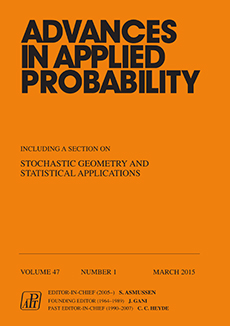Abstract
Density dependent Markov population processes in large populations of size N were shown by Kurtz (1970), (1971) to be well approximated over finite time intervals by the solution of the differential equations that describe their average drift, and to exhibit stochastic fluctuations about this deterministic solution on the scale √N that can be approximated by a diffusion process. Here, motivated by an example from evolutionary biology, we are concerned with describing how such a process leaves an absorbing boundary. Initially, one or more of the populations is of size much smaller than N, and the length of time taken until all populations have sizes comparable to N then becomes infinite as N → ∞. Under suitable assumptions, we show that in the early stages of development, up to the time when all populations have sizes at least N1-α for 1/3 < α < 1, the process can be accurately approximated in total variation by a Markov branching process. Thereafter, it is well approximated by the deterministic solution starting from the original initial point, but with a random time delay. Analogous behaviour is also established for a Markov process approaching an equilibrium on a boundary, where one or more of the populations become extinct.
Citation
A. D. Barbour. K. Hamza. Haya Kaspi. F. C. Klebaner. "Escape from the boundary in Markov population processes." Adv. in Appl. Probab. 47 (4) 1190 - 1211, December 2015. https://doi.org/10.1239/aap/1449859806
Information





